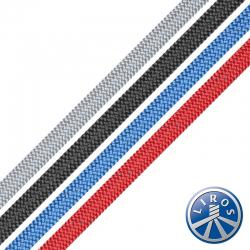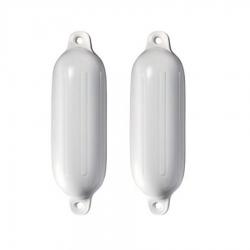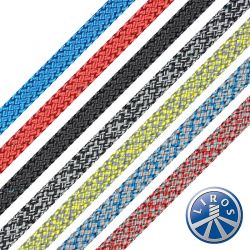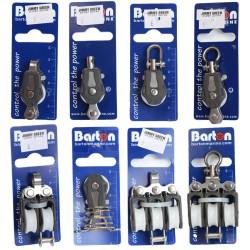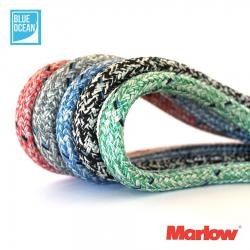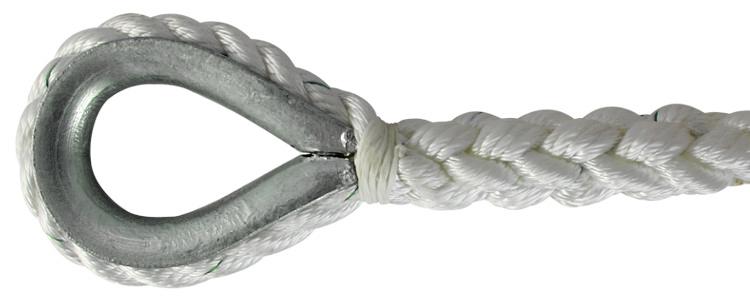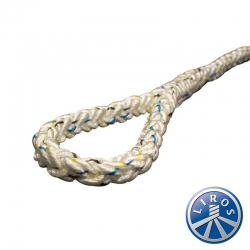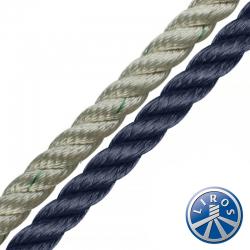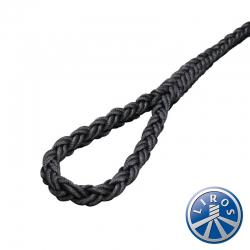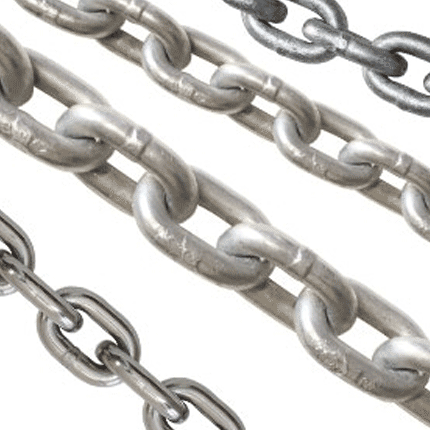Updated January 2023
The Best Anchor Ropes for your Motorboat or Sailing Yacht
The best ropes for anchoring a motorboat or sailing yacht are manufactured from Nylon (Polyamide) or Polyester because they offer good value, substantial strength, the appropriate weight (they both sink), and excellent shock-absorbing properties (stretch).
What are the Main Properties to look for in an Anchor Rope?
Strength
Strength is essential because the rope will need to be strong enough to safely withstand the pulling load created by your yacht and all the equipment and crew on board.
Weight
The weight of the rope fibre helps the line to sink naturally, which improves the direction of the pull on the anchor.
Stretch
Stretch is crucial because the line needs to absorb the shock when the waves, wind and current combine to cause sudden or abrupt spikes in the strain. If the line doesn’t give, the result is an unpleasant onboard motion. In addition, there are potentially more severe consequences: jerking the anchor from its holding position, straining the fixings of the deck attachment point or, in extremis, incurring failure in the weakest component.
Durability
An anchor rope must withstand the wear and tear caused at one end by contact with the seabed and at the other by rubbing where it passes over the bow roller or through the toe rail fairleads. Part of the line may also be exposed to the sun’s harmful rays for extended periods, so good UV resistance is desirable, especially in sunny climes, e.g. the Mediterranean and the Tropics.
Handling and Storage
When dropping anchor and retrieving it again, you will need to deal with the rope, which may be very long. Knowing how the anchor line will likely behave as it passes through your hand and over the bow into the water or back into the chain locker or storage container will be crucial to satisfactory performance. You don’t want it to end in a tangled mess in either direction.
Splice-ability
The rope construction must be splice-able, i.e. capable of being successfully spliced.
Tying a knot reduces the breaking strain by up to 50%, and strength is essential, as reported above.
A well-formed splice will retain approximately 90% of the breaking strain.
The Most Important Splices for Anchoring Ropes:
Thimble Eye Splice - an eye formed around a heart-shaped thimble (nylon, galvanised or stainless steel) for attachment with a shackle.
Loop Splice – a loop of any length to attach to a deck cleat or strongpoint.
Rope to Chain Splice - a splice formed around the end link of an anchor chain or intertwined along multiple links of an anchor chain - for joining the rope directly to the chain without any shackles.
Which Rope Fibres are best for Anchoring
Nylon (Polyamide) and Polyester are synthetic manufactured fibres eminently suited to anchoring because they offer all the previously highlighted properties: Strength, Weight, Stretch, Durability, and Splice-ability.
Nylon is the most commonly used of the two, but Polyester is equally suitable.
The below table illustrates at a glance how Nylon and Polyester have similar star quality ratings for anchoring:
Nylon versus Polyester for Anchor Rope
| Properties |
Nylon |
Polyester |
| Strength |
☆ ☆ ☆ ☆ ☆ |
☆ ☆ ☆ ☆ |
| Density, Weight, Sinking potential in water |
☆ ☆ ☆ ☆ |
☆ ☆ ☆ ☆ ☆ |
| Stretch |
☆ ☆ ☆ ☆ ☆ |
☆ ☆ ☆ ☆ |
| Resistance to salt water and chemicals |
☆ ☆ ☆ ☆ ☆ |
☆ ☆ ☆ ☆ ☆ |
| Resistance to abrasion |
☆ ☆ ☆ ☆ ☆ |
☆ ☆ ☆ ☆ ☆ |
| Resistance to sunlight |
☆ ☆ ☆ ☆ |
☆ ☆ ☆ ☆ ☆ |
| Handling and Stowage |
☆ ☆ ☆ ☆ |
☆ ☆ ☆ ☆ ☆ |
| Splicing |
☆ ☆ ☆ ☆ ☆ |
☆ ☆ ☆ ☆ ☆ |
| Value |
☆ ☆ ☆ ☆ ☆ |
☆ ☆ ☆ ☆ ☆ |
Star Quality Ratings:
- 5 ☆ = Excellent
- 4 ☆ = Good
- 3 ☆ = Average
- 2 ☆ = Mediocre
- 1 ☆ = Poor
More Information on Anchoring Rope Star Qualities
Strength
Although the breaking strain of nylon is initially higher than polyester, they have very similar strength when subjected to a wet marine environment.
When you look at a break load chart, the tensile values are for new dry, unused rope, but polyester retains more strength than nylon when they have been in contact with seawater, making them more or less equal in practical boating strength terms.
Weight
Polyester is slightly heavier than Nylon, but they both sink rather than float.
Stretch
Polyester has less stretch capability than nylon and may not absorb shock loads to the same extent, but this can be offset by adding a compensator (rubber snubber). The elongation at rupture (when the rope breaks) is generally accepted as approximately 15% for Polyester and 25% for Nylon. Both have excellent ductile properties, which is crucial to anchoring endurance because they return to their original uncompromised state after stretching under a working load.
Durability
Polyester and Nylon both have superb abrasion resistance.
Polyester and Nylon are equally resistant to salt ingress, harmful chemicals, and other water pollutants.
Polyester has the best resistance to UV degradation, so it is a logical choice for sunnier climes. Nylon is regarded as sufficiently resilient for the exposure that occurs when anchoring, especially if it is stored in a covered locker.
Splice-ability
Polyester and Nylon can be spliced to retain the maximum strength of the rope with equal success.
A professional splice is always recommended, whichever option you choose because it will give you peace of mind.
Handling and Stowage
Polyester will stay supple throughout its working life, while Nylon tends to stiffen, more noticeably in larger diameters, 18mm and above. This is due to the Nylon fibres shrinking when drying out after marine use and tightening the strands.
Initial Cost and Long-Term Value
Polyester is initially a little more expensive than Nylon per metre, but this should be compensated over time by a longer working life expectancy.
What are the Major Types (construction) of Anchor Rope
There are three major rope constructions for Polyester and Nylon Anchor Ropes:
3-Strand

The traditional twisted lay format – the three strands are formed from twisted fibres and then woven into a spiral construction.
This is the least expensive type of anchor rope, but it isn’t as easy to handle as the Eight Strand or Braid on Braid options.
Handling will become progressively more difficult as the diameter increases. So, for small boat anchor ropes up to 10mm or 12mm, it should be possible to push the line into the locker or container (bucket or bag) without special treatment. However, for larger diameters, skill and experience will be required to roll the rope through your hands just enough to form a rounded coil as you stow it.
Polyester’s suppleness is a progressively significant advantage over Nylon for three-strand anchor ropes as the diameter increases. Three strand Nylon performs admirably from 6mm to 12mm or 14mm diameter and potentially up to 16mm. Three-strand Polyester will be more flexible than the equivalent Nylon for any given diameter, but they will both prove challenging in sizes larger than 16mm.
8-Strand

A modern complex format involving four pairs of strands. The strands are individually formed by the traditional method of twisting the fibres. However, the eight strands are divided into two pairs of left-hand lay (meaning spun in a left-hand direction) and two pairs of right-hand lay (spun in the opposite, right-hand direction). This results in a balanced construction which can articulate. These 8-strand ropes go by many names: Anchorplait, Octoplait, Multiplait, Squareline, and GeoSquare.
Anchorplait (Octoplait 8-strand) is the optimum construction for anchoring because it doesn’t need any special skill or dexterity to stow it or pay it out. Instead, Anchorplait flakes into a locker like an anchor chain, happily dropping and landing on top of the chain or itself without tangles. The only significant downside to Nylon compared with Polyester is Nylon’s tendency to stiffen when wet, and this is nullified by the Eight Strand format making Anchorplait Nylon the ultimate choice for anchoring.
Braid on Braid (Doublebraid)

A handy but less common option for anchoring, typically incorporating some lead in the last five or ten metres to add extra weight.
Doublebraid lines are typically used on small boats and dinghies due to their excellent handling and stowage qualities and sometimes on larger yachts with lead incorporated instead of an anchor chain for a backup, secondary or kedge anchor.
Combining Rope and Chain to form an Anchor Rode
A length of chain will complement your anchor rope for these principal reasons:
- The added weight will help the anchor sink in the sand or the mud.
- The extra weight will make the pull on the anchor more horizontal, building on the fact that the anchor rope sinks, avoiding an upward yank which might cause the anchor to break out and drag along the seabed.
- More chain will improve the shock absorption of the anchor rode because the applied forces will need to lift and straighten the chain before the dampening effect of the rope’s elasticity is brought into play.
- The chain will keep the anchor rope away from the abrasive chafing effects of the seabed.
Anchoring Ropes for use with a Windlass
The best way to connect your anchor rope to your anchor chain for use on a windlass is to splice the two together.
The splice between the anchor rope and chain will run smoothly through the windlass gypsy. Otherwise, the join will require inconvenient manhandling to the chain locker or transferring to a warping drum.
Polyester and Nylon are suitable for use on a rope/chain windlass gypsy and splice readily to chain.
3-Strand and 8-Strand Anchorplait/Octoplait ropes can be spliced around and through the end link of an anchor chain and back on itself to produce an impressively strong joint.
Alternatively, 8-Strand Anchorplait/Octoplait rope can be intertwined along and through the first 11 links of the chain and made off securely to form a good splice. All these splices have been proven over decades of anchoring use, but they should be regularly inspected for signs of wear to ensure the integrity of your anchoring system.
A professional splice is recommended because it will be critical to the enduring successful performance of the anchor rode.
3-Strand and 8-Strand Anchorplait/Octoplait ropes are compatible with most modern windlass gypsys.
Please note that you should always consult the windlass manufacturer’s recommendation on rope construction and diameter.
Windlass manufacturers stipulate a rope diameter range and a chain calibration for each gypsy, and some specify only 3-strand rope.
Please be aware that some gypsys are designed to only work with chain and will subsequently chew up your anchor rope.
Jimmy Green Anchor Ropes:
Our Anchor Ropes are all manufactured by LIROS Ropes in Germany.
We have been promoting and extolling the virtues of LIROS Ropes for over 40 years.
LIROS are world-renowned for rope manufacturing to a consistently high quality.
The LIROS design and engineering team use the most advanced production techniques and technologically advanced rope-making machinery in their modern eco-friendly, energy-efficient factory.
LIROS Anchorplait® White Nylon - Article 01058JG

Anchorplait® is a Jimmy Green Marine registered trademark - UK00003834831
Anchorplait ® is manufactured by LIROS Ropes exclusively for Jimmy Green Marine
Anchorplait® features Easy Splice Markers designed by the Jimmy Green Rigging Team
Star Qualities:
- LIROS manufacturing excellence and consistency
- 100% UV stabilised Nylon (Polyamide)
- Superlative shock absorption
- Excellent weathering
- Excellent wear resistance
- The 8-strand construction (two pairs left hand, two pairs right hand) ensures a balanced performance and no twist under tension.
- Zero possibility of cockling
- Superb handling, manageable in long lengths
- Falls and flakes like a chain
- Remains supple for the duration of its working life
- Splice-able - very strong 1-link splice to chain or flexible 11-link splice to chain
- Available from 10mm up to 20mm diameter
Potential Disadvantages:
- More expensive than the 3-Strand version
- Initially more prone to snagging than 3-strand – until the strands are bedded in under load
- Not recommended as gypsy compatible by some windlass manufacturers, offset by customers not knowing or ignoring this advice and experiencing trouble-free use over decades.
Jimmy Green also offer 24mm, 28mm and 32mm diameter 8-strand Anchor Rope versions from LIROS (Octoplait), Marlow (Multiplait) or Gleinstein (GeoSquare) in plain white with only the manufacturer marker yarn for identification.
LIROS 3 Strand White Nylon - Article 00110

Star Qualities:
- Less expensive than the 8-Strand Anchorplait/Octoplait version
- LIROS manufacturing excellence and consistency
- LIROS apply spiral heat setting technology to the twist tension to ensure the long-term integrity of the three strands
- The LIROS Design Team meticulously adjust the twist tension during manufacture to offset the stiffening effect of nylon when the fibres inevitably become saturated in water and shrink when drying out
- 100% UV stabilised Nylon (Polyamide) manufactured to DIN EN ISO1140
- Excellent shock absorption
- Excellent weathering
- Outstanding chafe and wear resistance
- Splice-able - very strong 1-link splice to chain
- 100% compatible with all rope/chain combination gypsys
- Recommended as the only compatible rope construction by some windlass manufacturers
- Available from 6mm up to 24mm diameter
Potential Disadvantages:
- Manageable handling in smaller diameters, challenging in 18mm and above
- Requires traditional thumb roll dexterity for forming into a hank
- Shrinks when drying out, causing a tightening of the strands resulting in a stiffening effect which is progressively more challenging for larger diameter ropes
LIROS Octoplait Polyester - Article 01049

Star Qualities:
- LIROS manufacturing excellence and consistency
- 100% Polyester
- Excellent shock absorption
- Superlative weathering and UV resistance
- Excellent wear resistance
- The 8-strand construction (two pairs left hand, two pairs right hand) ensures a balanced performance and no twist under tension.
- Zero possibility of cockling
- Superb handling, manageable in long lengths
- Falls and flakes like a chain
- Remains flexible and supple for the duration of its working life
- Splice-able - very strong 1-link splice to chain or flexible 11-link splice to chain
- Available from 10mm up to 24mm diameter
Potential Disadvantages:
- Not as stretchy as Nylon
- Initially more prone to snagging than 3-strand – until the strands are bedded in under load
- Not recommended as gypsy compatible by some windlass manufacturers, offset by customers not knowing or ignoring this advice and experiencing trouble-free use over decades
LIROS 3 Strand White Polyester - Article 00111/01110

Star Qualities:
- Less expensive than the 8-Strand Anchorplait/Octoplait version
- LIROS manufacturing excellence and consistency
- LIROS apply spiral heat setting technology to the twist tension to ensure the long-term integrity of the three strands
- 100% Polyester
- Manufactured to DIN EN ISO1141
- Excellent shock absorption
- Superlative weathering and UV resistance
- Excellent wear resistance
- Excellent handling
- Remains flexible and supple for the duration of its working life
- Splice-able - very strong 1-link splice to chain
- Recommended as the only compatible rope construction by some windlass manufacturers
- Available from 6mm up to 24mm diameter
Potential Disadvantages:
- Requires traditional thumb roll dexterity for forming into a hank
LIROS Handy Anchor - Leaded Anchor Warp

Star Qualities:
- LIROS manufacturing excellence and consistency
- Balanced Braiding, Non-Kinking Braid on Braid (Doublebraid) Construction
- 100% Polyester fibre
- Bright finish
- Superlative comfortable handling
- Extremely convenient to stow
- Lead weight built into the last 10 metres
- User-friendly because it can be used without a length of chain
- Stainless thimble eye splice included for attaching to the anchor
- Available in set lengths: 30 metres x 10mm, 30 metres x 12mm, 40 metres x 14mm, 40 metres x 16mm
- Supplied in a convenient canvas stowage bag
Our Knowledge Centre has more in-depth information and guidance articles for all your anchoring needs.
Anchoring System Assessment
Anchor Chain and Rope Size Guide
Anchor Chain Snubbing Guide
Main Menu
Main Menu
Back
Main Menu
Back
Main Menu
Back
Back
Main Menu
Back
Main Menu
Back
Back
Main Menu
Back
Main Menu
Main Menu
Back
Main Menu
Back
Back
Back
Back
Back
Back
Back
Back







